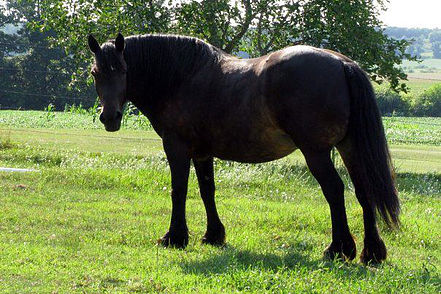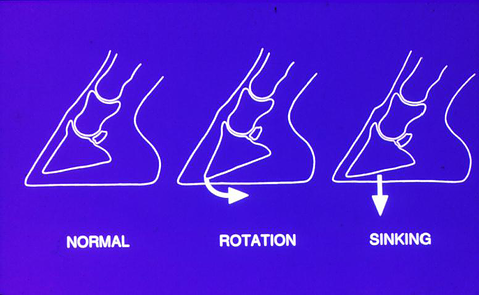Laminitis is the inflammation of the tissues which connect the hoof wall to the coffin bone. This can occur in horses of any age, sex and size, and it can occur due to multiple factors. Severity may range from mild to very severe cases in which euthanasia may be recommended as the most humane option. Some cases are of short duration and others may lead to chronic conditions that cause permanent lameness. Each year approximately 1.4% of the horse and pony population suffers from acute laminitis, and another 1.8% struggles with chronic laminitis.
Some risk factors for laminitis include:
- over consumption of lush pasture
- excessive grain
- obesity
- equine metabolic syndrome or equine cushings
- mares who retain their placenta after foaling
- weight bearing injuries placing extra stress on opposite limbs
- trauma or injury to a limb or hoof
- exposure to toxic substances, i.e. black walnut shavings
- diarrhea or other systemic infections
- long term or excessive steroid use
“Founder” describes a subset of laminitis cases in which the coffin bone rotates away from the hoof capsule.
So what signs do we look for when determining if a horse or pony has laminitis? Clinical signs include a reluctance to move and lameness especially in the front limbs, lethargy, sweating, and increased respiratory and heart rate. Affected horses may be resistant to pick up their feet, have a difficult time turning, have a characteristic “saw horse” stance, and are more painful on hard ground. Some horses may spend an increased amount of time lying down. In more mild cases, the horse may simply appear stiff.

Characteristic laminitis stance with the front limbs extended in front, and the hind limbs positioned under the body to bare more of the horse’s weight.
Your veterinarian will do an exam of your horse, as well as discuss a complete history of your horse to determine if he or she is affected by laminitis. An exam may include hoof testing, nerve blocks, and x-rays. Bloodwork or other diagnostics may also be recommended depending on the case.
Prevention is key! Limit grazing and/or use a grazing muzzle prevent weight gain or assist with weight loss in obese horses. Proper hoof care every 6-8 weeks, with shoeing if needed, is important. If the horses are not laminitic, exercise can aid in facilitating weight loss. Watch for clinical signs of Metabolic Syndrome (young to middle aged horses, excess fat deposition, weight gain, lameness) or Cushing’s (horses 15 years and older, excessive weight gain, long hair coat, excess sweating, increased drinking and urination, recurrent infections or lameness) and schedule an appointment with your veterinarian if any of those signs are noted.
Treatment for laminitis may include:
- Anti-inflammatory medications (ex. bute, DMSO)
- Stall rest or exercise restriction
- Deep bedding or sand, or special boots to provide cushion for the feet
- Dietary restriction: grass hay and a vitamin/mineral supplement. No grass or grain!
- Proper medical treatment for other health concerns (ex. treatment of Cushing’s if present)
- Mechanical support with trimming +/- shoes
- Ice or cold-water therapy to the distal limbs where feasible
- Other therapies may be recommended on a case-by-case basis
If you see signs of laminitis in your horse or risk factors for developing laminitis, do not hesitate to call your veterinarian. Laminitis is considered an emergency as it can cause serious life-altering changes if left untreated. Remember, it is always better to prevent this disease rather than treating it.



